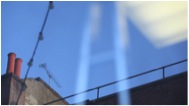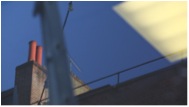
Figure. 1. Same window, same ladder, on different days and different sides of the window
The technique of cutting on action to connect discontinuous spaces and times is one that has been employed in films as different as Meshes Of the Afternoon, Midnight Cowboy and William Raban’s Autumn Scenes, typically serving to dissolve distinctions between physical and mental experience. As Maria Pramaggiore writes of Deren’s character in Meshes, although her body creates continuity across disparate spaces, “she is also fragmented because she occupies, and sutures together, impossible spaces” (1997, 30). In this case it is the subject that makes the impossible possible, but significantly this entails a certain sacrificing, or de-suturing, of subjectivity itself. In the case of Raban’s film, a different emphasis emerges in his artist’s statement posted online: he writes that the “illusion of continuity does not constitute an adequate model for perception, which is manifestly less lineal and more fragmentary”, a thought echoed by Nathaniel Dorsky who discusses and celebrates the ‘intermittent’ nature of experience in his book, Devotional Cinema (2005). For Raban and Dorsky the emphasis is on film’s unique ability to say something about the intermittent quality of our contact with the sensory world, in part because film itself is made up of still, intermittently projected images masquerading as continuous motion. It is clear that for them the continuity style of editing misrepresents lived experience by smoothing over the cracks of our sensory encounters in particular.
‘Radical continuity’ is András Bálint Kovács’ (2008) term for the editing technique under investigation here, confused only slightly by the fact that the term is also applied — by him and by others — to long take cinema where very few cuts are used, and where montage is more likely to happen within the shot. Nonetheless, one of these techniques is radically continuous in a physical sense, and the other is radically continuous in a subjective, or imaginary sense.
In this article I suggest that radical continuity’s ability to connect discontinuous spaces and different timeframes might also be used to address a particular problematic concerning ‘the everyday’, and that this argument, furthermore, might also be seen to be operating in my film, Everything Is Everyday (2011). Maurice Blanchot (2011: 241) argues that we can either talk about ‘the everyday’ or we can live the everyday, but we can’t do both at once. As soon as you start abstracting and conceptualizing ‘the everyday’ — so the logic goes — you have necessarily stepped outside of the mundane world that is actual, everyday experience. But if radical continuity makes it possible to transmit ideas and forms across discontinuous fields, perhaps it can also facilitate a movement between ‘the everyday’ and everyday experience and thereby trace an image of these as intersecting, rather than mutually exclusive, spheres.
My silent, ten-minute portrait of a window cleaner contains fifty-four shots that were all recorded on different days over the course of a year. So one way that our ‘everyday’ spheres might be seen to intersect lies in the idea that if every cut signals a new day, as it does in this film, then as sure as night separates days it is a real, everyday duration that is being elided with each cut. Insofar as the shots in this film might represent ‘the everyday’ — by depicting mundane labor — it is in the gaps between these shots that real duration, the duration of everyday experience and labor, lies. For the spectator that understands that every shot in this film was recorded on a different day (a fact readily shared in program notes) there is an embodied knowledge about lived time that they are capable of bringing to that equation. Although there are many other factors in play that will determine if this happens in fact, nonetheless a certain kind of durational meaning adheres to the gaps in the film and it requires a spectator to activate this meaning; to bring their experience of an embodied, everyday duration to bear on what would otherwise just be cuts in time, rather than cuts with time. In simple terms, for the labor on screen to attain the weightiness of real work, it must do so in the empathetic bodies of the spectators in the cinema.
Significantly, the sense of lived time that any spectator might supply is off-screen time, both in the sense that it is the meaningful experience and idea that lies invisibly between shots, but also in the sense that the spectator supplies a sense of duration that is largely derived from a time and place outside of the cinema. There is, of course, another important experience of off-screen time at work in the window cleaner himself, for it is indeed the real time between his days and between his windows that gives his labor a sense of the weight it deserves. He might appear to be painting his way effortlessly across time and space, but he isn’t really. The two distinct ‘everyday’ spheres described by Blanchot intersect in Everything Is Everyday in the same way that shots and cuts intersect, or in the way that onscreen time and off-screen time intersect. They intersect, not in a material sense, but in the mind of the spectator who must contend with the way that one inflects our reading of the other. In this case the spectator is invited to contend with the way that a representation of ‘the everyday’ — in the form of repetitive, everyday labor that spans time — impacts upon their understanding of the film’s interstices, where the real time of the everyday is to be found.
To put this last point in different terms, the hard and fast rule that I observed — that only one shot may be used from any day’s filming — constitutes the film’s structural underpinning. Hence the film is founded on a particular program of editing, not on anything else. At the same time, there is nothing pre-determined or systematic about when a shot should be cut. What I am describing here is yet another intersection; in this case between two very different notions of editing and time. The first edit of the film entails a cut from a ladder being carried on the inside of a window to the same ladder being carried on the external, near side of the same window (see Figure 1). The cut is a match on action, which means we switch from one day to another in a gesture that is more or less seamless at the level of movement, but which involves an otherwise impossible transition in space and time. What emerges in this instant is that my decision about when to cut has in fact been largely determined by my desire to shine a light on the film’s deep structural interest in the way that days pass and labor persists. In short, I have been motivated to highlight the edit and to do this via the conventions of radical continuity; conventions that give the editor very little leeway. Although this technique is only one way to deal with activities that recur over time, and only one way to edit shots together in my film, it is the very first technique employed, and it is a technique that is repeated. Throughout Everything Is Everyday I make editing decisions according to a range of criteria, but these criteria cannot escape the gravitational pull of the most important editing decision of all, the one that exploits the nights that separate days. This means that a poetic response to the challenge of editing intersects another, more structural concern — these two drives, again, being mutually inflecting rather than mutually exclusive.
What emerges from this discussion is an image of intersections, where poetic editing intersects structural editing; where the onscreen time of shots intersects the off-screen duration in the gaps; and where a concept of ‘the everyday’ might intersect everyday experience. Giles Deleuze writes: “The splendour of nature, of a snow covered mountain, tells us one thing only: everything is ordinary and regular, everything is everyday!” (1989: 15). But when Deleuze says that ‘everything is everyday’ he is transposing Blanchot, who says that “in the everyday, everything is everyday” (2011: 241) [my emphasis]. In Blanchot’s configuration everything is only everyday when you’re in it, whereas Deleuze is suggesting that you are always in it. Perhaps it is Deleuze’s conception that is closest to my ambition for this film, for it seems to allow more possibility for a sense of awe and the ordinary to coexist, for a soapy swipe to turn radically into a painterly flourish via the duration of the gap.
References:
Blanchot, Maurice. (2011) The Infinite Conversation. Susan Hanlon Trans. (6th Edition). Minneapolis: University of Minnesota Press.
Deleuze, Gilles (1989) Cinema 2: The Time-Image. Minneapolis, MN: University of Minnesota Press.
Dorsky, Nathaniel (2005). Devotional Cinema, 2nd Edition. Berkley: Tuumba Press.
Kovács, András Bálint (2008) Screening Modernism: European Art Cinema, 1950-1980. Chicago: University of Chicago Press.
Pramaggiore, Maria (1997) “Performance and Persona in the U.S. Avant Garde: The Case of Maya Deren” in Cinema Journal, Vol. 36, No. 2 (Winter), pp. 17-40. Texas: University of Texas Press.
Raban, William. LUXONLINE. Artist’s statement for Autumn Scenes (1978) http://www.luxonline.org.uk/artists/william_raban/autumn_scenes.html


1 comment for “Radical Continuity and The Everyday”